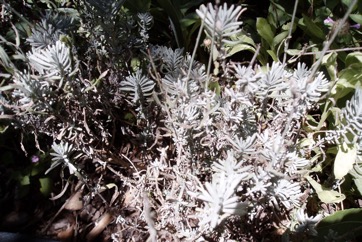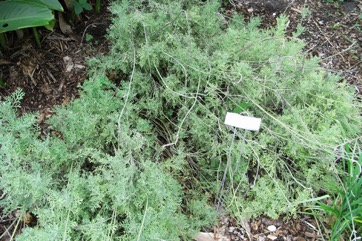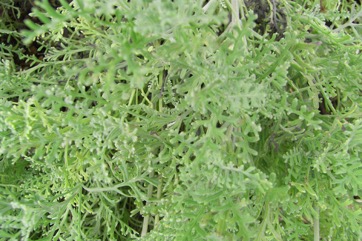English Lavender, Common lavender

It is a temperate plant. It suits dry exposed sunny positions. It needs a well drained alkaline soil. It is a plant that can withstand frost. It does not suit the tropics or very humid areas. It does best in cool or warm climates with a winter rainfall. It grows between 600-1200 m altitude in southern Europe. It suits hardiness zones 5-10.
Also known as:
Espigol, Lavanda, Lavender, True Lavender, Xun yi cao
Synonyms
- Lavandula officinalis Chaix
- Lavandula spicata L.
- Lavandula vera DC
Edible Portion
- Flowers as flavouring, Herb, Spice, Leaves - tea
Where does English Lavender grow?
Found in: Africa, Asia, Australia, Britain, Canada, China, Congo DR, Crimea, Croatia, Europe, France, Greece, India, Indonesia, Italy, Mediterranean, New Zealand, North America, Pakistan, SE Asia, Serbia, Spain, Switzerland, Tasmania, Yugoslavia
Notes: There are about 28 Lavandula species.
Growing English Lavender, Common lavender
Cultivation: Seeds often take a long time to germinate. Also seeds do not always breed true to type. Plants are better grown from cuttings. A 4 cm tip cutting with a base of old wood is what is best used for cuttings. If flowers are removed during the first year tougher bushier plants result.
Edible Uses: Fresh or dried flowers and leaves can be used can be used to flavour jellies, ice cream and cheeses. The leaves, petals and flowering tips are added to salads, dressings, soups, stews, jams and jellies. The flowers can be candied and used as garnish in soft drinks. Fresh or dried flowers are used for tea. It yields an essential oil used as flavouring in food manufacture.
Production: The flowers are harvested in the early morning.
Nutrition Info
per 100g edible portion| Edible Part | Energy (kcal) | Protein (g) | Iron (mg) | Vitamin A (ug) | Vitamin c (mg) | Zinc (mg) | % Water |
|---|---|---|---|---|---|---|---|
| - | - | - | - | - | - |
English Lavender, Common lavender Photos



References
Abbet, C., et al, 2014, Ethnobotanical survey on wild alpine food plants in Lower and Central Valais (Switzerland). Journal of Ethnopharmacology 151 (2014) 624–634 (As Lavandula officinalis)
Ambasta, S.P. (Ed.), 2000, The Useful Plants of India. CSIR India. p 319
Blamey, M and Grey-Wilson, C., 2005, Wild flowers of the Mediterranean. A & C Black London. p 401
Bodkin, F., 1991, Encyclopedia Botanica. Cornstalk publishing, p 622
Bremness, L., 1994, Herbs. Collins Eyewitness Handbooks. Harper Collins. p 112
Brown, D., 2002, The Royal Horticultural Society encyclopedia of Herbs and their uses. DK Books. p 251
Burnie, G & Fenton-Smith, J., 1999, A Grower's Guide to Herbs. Murdoch Books. p 42
Cundall, P., (ed.), 2004, Gardening Australia: flora: the gardener's bible. ABC Books. p 801
Dolina, K. & Luczaj, L., 2014, Wild food plants used on the Dubrovnik coast (south-eastern Croatia) Acta Soc Bot Pol 83(3):175–181
Etherington, K., & Imwold, D., (Eds), 2001, Botanica's Trees & Shrubs. The illustrated A-Z of over 8500 trees and shrubs. Random House, Australia. p 425
Facciola, S., 1998, Cornucopia 2: a Source Book of Edible Plants. Kampong Publications, p 126
Gard. dict. ed. 8: Lavandula no. 2. 1768
Hedrick, U.P., 1919, (Ed.), Sturtevant's edible plants of the world. p 374 (As Lavandula vera)
Hemphill, I, 2002, Spice Notes. Macmillan. p 218
Hibbert, M., 2002, The Aussie Plant Finder 2002, Florilegium. p 179
Hussey, B.M.J., Keighery, G.J., Cousens, R.D., Dodd, J., Lloyd, S.G., 1997, Western Weeds. A guide to the weeds of Western Australia. Plant Protection Society of Western Australia. p 168
Joyce, D., 1998, The Garden Plant Selector. Ryland, Peters and Small. p 147
Karhagomba, I. B., et al, 2013, The cultivation of wild food and medicinal plants for improving community livelihood: The case of the Buhozi site, DR Congo. Nutrition Research and Practice (Nutr Res Pract) 2013;7(6):510-518 (As Lavandula officinalis)
Kiple, K.F. & Ornelas, K.C., (eds), 2000, The Cambridge World History of Food. CUP p 433, 1799 (As Lavandula officinalis)
Kremer, B.P., 1995, Shrubs in the Wild and in Gardens. Barrons. p 85.
Lawton, B.P., 2002, Mints. A Family of Herbs and Ornamentals. Timber Press, Portland, Oregon. p 140
Li Hai-wen, Hedge, I.C., Lamiaceae. Flora of China.
Lord, E.E., & Willis, J.H., 1999, Shrubs and Trees for Australian gardens. Lothian. p 242
PROSEA handbook Volume 13 Spices. p 277
Rigat, M et al, 2009, Ethnobotany of Food Plants in the High River Ter Valley (Pyrenees, catalonia, Iberian Peninsula): Non-Crop Food Vascular Plants and Crop Food Plants with medicinal Properties. Ecology of Food and Nutrition, 48:303-327
Seidemann J., 2005, World Spice Plants. Economic Usage, Botany, Taxonomy. Springer. p 200
Skinner, G. & Brown, C., 1981, Simply Living. A gatherer's guide to New Zealand's fields, forests and shores. Reed. p 47
Skinner, G. & Brown, C., 1981, Simply Living. A gatherer's guide to New Zealand's fields, forests and shores. Reed. p 47 (As Lavandula vera)
Tardio, J., et al, Ethnobotanical review of wild edible plants in Spain. Botanical J. Linnean Soc. 152 (2006), 27-71
Zeng, Y., et al, 2014, Evaluation of antioxidant activities of extracts from 19 Chinese edible flowers. SpringerPlus 2014, 3:315